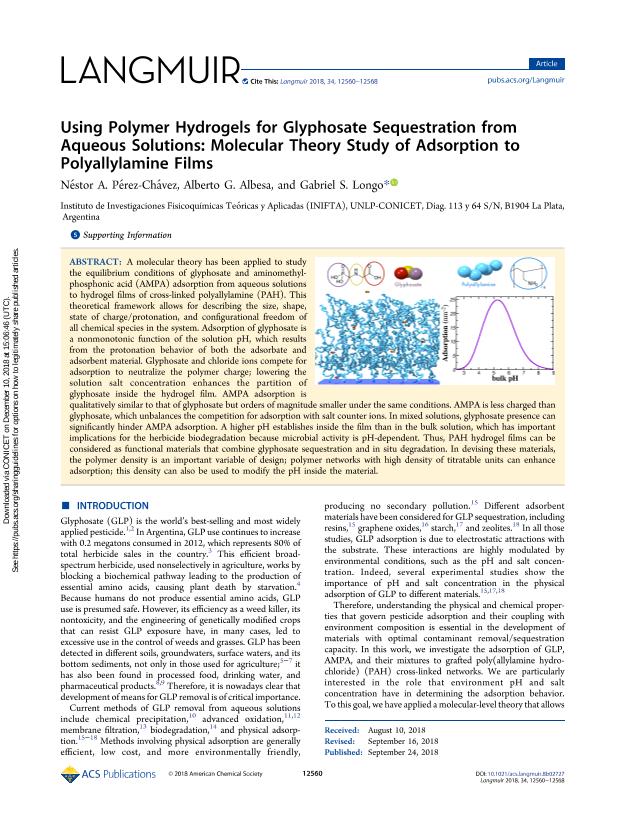Mostrar el registro sencillo del ítem
dc.contributor.author
Pérez Chávez, Néstor Ariel

dc.contributor.author
Albesa, Alberto Gustavo

dc.contributor.author
Longo, Gabriel Sebastian

dc.date.available
2020-03-25T21:01:23Z
dc.date.issued
2018-10
dc.identifier.citation
Pérez Chávez, Néstor Ariel; Albesa, Alberto Gustavo; Longo, Gabriel Sebastian; Using Polymer Hydrogels for Glyphosate Sequestration from Aqueous Solutions: Molecular Theory Study of Adsorption to Polyallylamine Films; American Chemical Society; Langmuir; 34; 42; 10-2018; 12560-12568
dc.identifier.issn
0743-7463
dc.identifier.uri
http://hdl.handle.net/11336/100827
dc.description.abstract
A molecular theory has been applied to study the equilibrium conditions of glyphosate and aminomethylphosphonic acid (AMPA) adsorption from aqueous solutions to hydrogel films of cross-linked polyallylamine (PAH). This theoretical framework allows for describing the size, shape, state of charge/protonation, and configurational freedom of all chemical species in the system. Adsorption of glyphosate is a nonmonotonic function of the solution pH, which results from the protonation behavior of both the adsorbate and adsorbent material. Glyphosate and chloride ions compete for adsorption to neutralize the polymer charge; lowering the solution salt concentration enhances the partition of glyphosate inside the hydrogel film. AMPA adsorption is qualitatively similar to that of glyphosate but orders of magnitude smaller under the same conditions. AMPA is less charged than glyphosate, which unbalances the competition for adsorption with salt counter ions. In mixed solutions, glyphosate presence can significantly hinder AMPA adsorption. A higher pH establishes inside the film than in the bulk solution, which has important implications for the herbicide biodegradation because microbial activity is pH-dependent. Thus, PAH hydrogel films can be considered as functional materials that combine glyphosate sequestration and in situ degradation. In devising these materials, the polymer density is an important variable of design; polymer networks with high density of titratable units can enhance adsorption; this density can also be used to modify the pH inside the material.
dc.format
application/pdf
dc.language.iso
eng
dc.publisher
American Chemical Society

dc.rights
info:eu-repo/semantics/openAccess
dc.rights.uri
https://creativecommons.org/licenses/by-nc-sa/2.5/ar/
dc.subject
pH-RESPONSIVE HYDROGELS
dc.subject
GLYPHOSATE SEQUESTRATION
dc.subject
MOLECULAR SIMULATIONS
dc.subject
POLY(ALLYLAMINE) FILMS
dc.subject.classification
Físico-Química, Ciencia de los Polímeros, Electroquímica

dc.subject.classification
Ciencias Químicas

dc.subject.classification
CIENCIAS NATURALES Y EXACTAS

dc.title
Using Polymer Hydrogels for Glyphosate Sequestration from Aqueous Solutions: Molecular Theory Study of Adsorption to Polyallylamine Films
dc.type
info:eu-repo/semantics/article
dc.type
info:ar-repo/semantics/artículo
dc.type
info:eu-repo/semantics/publishedVersion
dc.date.updated
2020-03-16T14:01:24Z
dc.journal.volume
34
dc.journal.number
42
dc.journal.pagination
12560-12568
dc.journal.pais
Estados Unidos

dc.description.fil
Fil: Pérez Chávez, Néstor Ariel. Consejo Nacional de Investigaciones Científicas y Técnicas. Centro Científico Tecnológico Conicet - La Plata. Instituto de Investigaciones Fisicoquímicas Teóricas y Aplicadas. Universidad Nacional de La Plata. Facultad de Ciencias Exactas. Instituto de Investigaciones Fisicoquímicas Teóricas y Aplicadas; Argentina
dc.description.fil
Fil: Albesa, Alberto Gustavo. Consejo Nacional de Investigaciones Científicas y Técnicas. Centro Científico Tecnológico Conicet - La Plata. Instituto de Investigaciones Fisicoquímicas Teóricas y Aplicadas. Universidad Nacional de La Plata. Facultad de Ciencias Exactas. Instituto de Investigaciones Fisicoquímicas Teóricas y Aplicadas; Argentina
dc.description.fil
Fil: Longo, Gabriel Sebastian. Consejo Nacional de Investigaciones Científicas y Técnicas. Centro Científico Tecnológico Conicet - La Plata. Instituto de Investigaciones Fisicoquímicas Teóricas y Aplicadas. Universidad Nacional de La Plata. Facultad de Ciencias Exactas. Instituto de Investigaciones Fisicoquímicas Teóricas y Aplicadas; Argentina
dc.journal.title
Langmuir

dc.relation.alternativeid
info:eu-repo/semantics/altIdentifier/url/http://pubs.acs.org/doi/10.1021/acs.langmuir.8b02727
dc.relation.alternativeid
info:eu-repo/semantics/altIdentifier/url/https://pubs.acs.org/doi/10.1021/acs.langmuir.8b02727
dc.relation.alternativeid
info:eu-repo/semantics/altIdentifier/doi/https://doi.org/10.1021/acs.langmuir.8b02727
Archivos asociados
